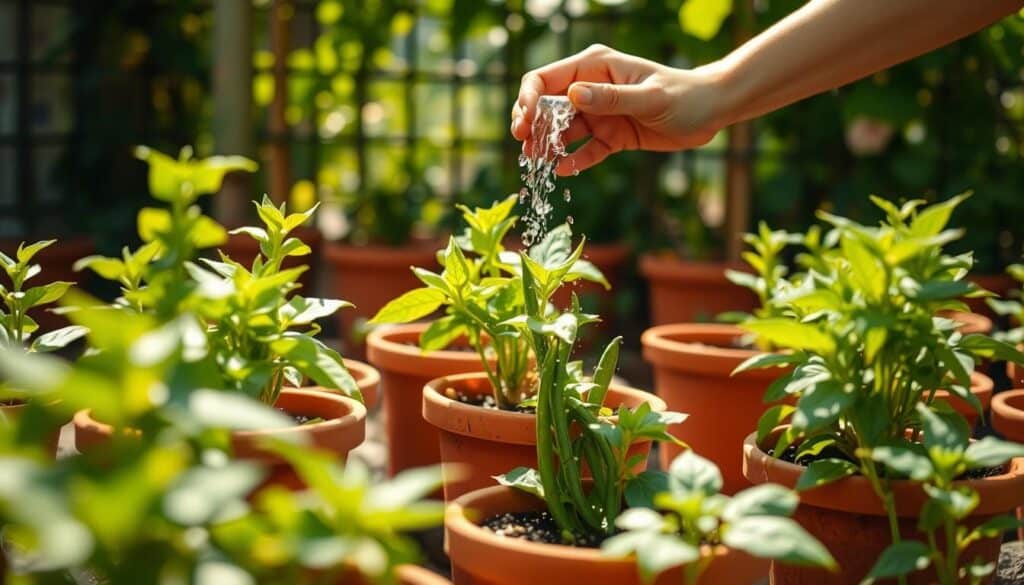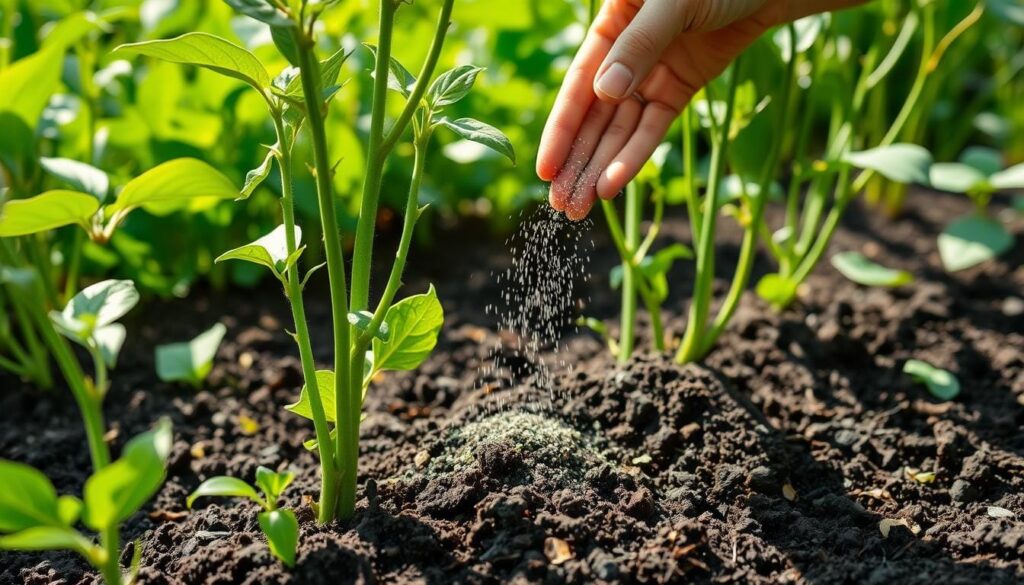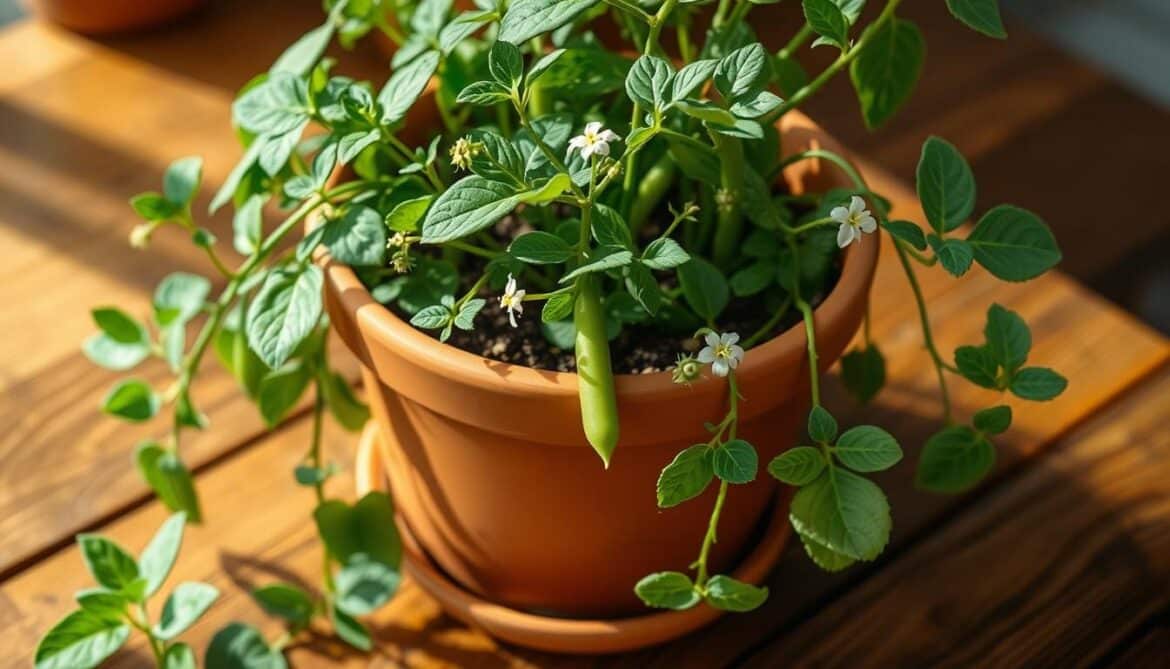Growing green beans in a pot turned my small balcony into a lively garden. With little outdoor space, I found growing green beans in pots is not only doable but also very fulfilling. We’ll show you how to grow green beans in a pot, proving that anyone can grow tasty, fresh produce, no matter the garden size.
Container gardening is a game-changer for city gardeners and those with small outdoor areas. Talking about growing green beans in containers means we’re exploring a flexible, easy way to grow healthy veggies at home. Whether you live in an apartment or a house, you can enjoy picking your own fresh green beans.
Key Takeaways
- Container gardening makes growing green beans accessible to everyone
- Both pole and bush bean varieties can thrive in pots
- Proper container selection is key for successful bean growth
- Sunlight, water, and soil quality greatly affect bean production
- Container beans can produce multiple harvests with proper care
Understanding the Benefits of Growing Green Beans in Pots
Container gardening is a great option for those with little space. Green bean pot gardening is now popular among city and suburban gardeners. They find it a smart way to grow their own food.
Looking into container gardening for green beans shows many benefits. It’s both fun and useful for gardeners of any skill level.
Space Efficiency for Your Garden
Container gardening turns small areas into productive spots. Whether you have a small balcony or a tiny backyard, growing green beans in pots is a great idea. Here are some space-saving tips:
- Use vertical spaces well
- Grow beans in areas with little ground space
- Move containers for better sunlight
Accessibility for Care and Harvest
Potted green beans are super easy to care for. You can check on plant health, adjust soil, and pick beans without bending. The benefits of container gardening for green beans include:
- Easy plant care
- Better pest control
- Harvesting at waist height
Aesthetic Appeal and Versatility
Green bean pot gardening also adds beauty to your space. Containers can be both useful and decorative. Picture vibrant green bean plants on your patio or deck, making your outdoor area both beautiful and edible.
By choosing container gardening, we can grow fresh, healthy green beans almost anywhere.
Choosing the Right Pot for Green Beans
Growing green beans in pots indoors needs careful thought about your container. The right pot is key to your plant’s health and success. We’ll look at what makes a pot perfect for your green bean plants.
Size Matters: Pot Dimensions for Optimal Growth
Container size is vital when growing green beans indoors. Here are some guidelines:
- Bush bean varieties: Minimum 12 inches deep
- Pole bean varieties: 18-24 inches deep
- Container volume: Approximately 288 cubic inches (4,719 cubic centimeters)
Drainage: The Lifeline of Container Gardening
Good drainage is key for growing green beans in pots indoors. Without it, root rot can harm your plants. Important drainage tips include:
- Use containers with 2-4 drainage holes at the bottom
- Select pots made from porous materials like terracotta or fabric grow bags
- Ensure soil allows water to pass through easily
Exploring Pot Material Options
Different pot materials have their benefits for growing green beans:
- Plastic Containers: Lightweight, affordable, retains moisture
- Terracotta Pots: Excellent breathability, natural drainage
- Fabric Grow Bags: Superior air pruning of roots, prevents overcrowding
Remember, your pot choice greatly affects your indoor green bean garden’s success. Pick the best one to ensure healthy, productive plants.
Selecting the Perfect Green Bean Variety
Growing green beans in containers is exciting for gardeners with little space. It’s important to know the unique traits of different beans and how they grow.
Bush Beans vs. Pole Beans: Understanding the Differences
For container gardening, you’ll find two main types: bush beans and pole beans. Bush beans are small and fit well in tiny containers. They grow fast, maturing in 50-55 days, and produce a lot of beans quickly.
Pole beans, by contrast, grow up and can get as tall as 8 feet. They are more productive per square foot and keep producing all season. They need a trellis but give you a longer harvest time.
Top Container-Friendly Green Bean Varieties
- Blue Lake Bush Beans: Quick-maturing and disease-resistant
- Contender: Excellent for small containers and cool climates
- Kentucky Wonder Pole Beans: Prolific producer with excellent flavor
- Maxibel Haricot Vert: Gourmet French-style green bean
Selecting Disease-Resistant Seeds
When choosing green beans for containers, pick disease-resistant seeds. Look for beans that fight off common problems like anthracnose and mosaic virus. Our picks are beans that do well in containers and grow strong.
Pro Tip: Choose varieties that match your specific growing conditions and container size for optimal results.
The right green bean variety can make your container garden great. Think about the space, sunlight, and what you like to eat when picking.
Preparing the Potting Soil
Creating the perfect potting soil for green beans is key for a successful container garden. The right mix gives your plants the nutrients they need, ensures good drainage, and provides the best growing conditions.
When making potting soil for green beans, aim for a balanced mix that supports healthy growth. The ideal mix should be light, rich in nutrients, and drain well.
Recommended Soil Mixtures
Our top choice for potting soil for green beans includes:
- Two-thirds high-quality potting mix
- One-third organic compost
- Perlite for better drainage
- Vermiculite for keeping moisture in
Importance of Nutrients
Green beans need specific nutrients to grow well in containers. A balanced mix ensures strong growth and a big harvest.
| Nutrient | Importance for Green Beans | Recommended Level |
|---|---|---|
| Nitrogen | Plant growth | Low (5-10-10 fertilizer) |
| Phosphorus | Root development | Medium |
| Potassium | Overall plant health | Medium to High |
Ensuring Proper pH Levels
The pH of your soil is vital for nutrient absorption. Green beans do best in slightly acidic to neutral soil with a pH of 6.0 to 7.0. Use a soil testing kit to check and adjust the pH if needed.
By focusing on these key aspects of potting soil preparation, you’ll create a perfect environment for your green beans. This will help you get a big harvest.
Planting Green Beans in Pots
Planting green beans in containers needs careful timing, technique, and care. This method is great for growing these nutritious veggies, even with little outdoor space.
When you’re ready to plant green beans in containers, timing is key. Wait until the soil is 55 to 60 degrees Fahrenheit. This is usually late spring after the last frost. The best growing conditions will help you get a big harvest.
Seed Placement Strategies
Proper seed placement is essential for container gardening. Here are some tips for planting green beans:
- Bush beans: Plant seeds 1 inch deep, 2-4 inches apart
- Pole beans: Plant seeds 1 inch deep, 4-6 inches apart
- Create multiple rows with 18-24 inches between them
Watering Techniques
Water your green bean seeds gently right after planting. Keep the soil moist but not too wet. Green beans need 1 to 2 inches of water per week during the growing season.
Pro Tip: Use a fine mist or gentle watering can to avoid displacing seeds during initial watering.
Remember, container gardening lets you control soil conditions and provide the best growing environments for your green beans.
Optimal Watering Techniques
Watering green beans in pots needs precision and careful attention. It’s important for their growth and a good harvest. Our guide will teach you how to water container-grown green beans well.

Understanding Moisture Needs
Green beans do best with consistent moisture. They need 1 to 1.5 inches of water per week. Because container plants dry out faster, you must check them more often. When you water, make sure the soil is moist but not too wet.
- Check soil moisture daily during hot weather
- Water when the top inch of soil feels dry
- Ensure deep watering that penetrates 6-8 inches
Signs of Overwatering
Too much water can harm your green beans as much as too little. Look out for these signs of overwatering:
- Yellowing leaves
- Wilting despite moist soil
- Stunted growth
- Root rot
Best Watering Practices
To water green beans in pots effectively, follow these tips:
- Use a 2-3 inch layer of organic mulch to retain moisture
- Consider self-watering containers for consistent hydration
- Water deeply but less frequently
- Adjust watering during heat waves
Consistent moisture is essential for healthy green bean plants. With the right care and these watering tips, you’ll have a thriving container garden. It will give you delicious beans all season long.
Ensuring Adequate Sunlight
Sunlight is key for growing green beans in pots indoors. Without enough light, your plants may not grow well or produce much. Knowing what green beans need helps you make a great place for them to grow.
Ideal Sunlight Requirements
Green beans love the sun and need specific light to grow strong. They need at least 6-8 hours of direct sunlight each day. To grow them indoors, place their pots near windows with lots of light.
- South-facing windows give the most sunlight
- Make sure they get at least 6 hours of direct light
- Use grow lights if natural light is not enough
Rotating Pots for Even Growth
Light that’s not even can make plants grow unevenly. By rotating your green bean pots every few days, you ensure they get light all around. This helps them grow straight and strong.
Using Reflective Surfaces
To get more light, use reflective surfaces around your green bean pots. White walls, aluminum foil, or grow room reflectors can help. They make the light stronger, giving your plants more to grow on.
| Light Requirement | Indoor Growing Strategy |
|---|---|
| Direct Sunlight | 6-8 hours near south-facing window |
| Supplemental Light | LED grow lights for 4-6 additional hours |
| Pot Rotation | Rotate every 2-3 days for even growth |
“Sunlight is the secret ingredient in successful indoor vegetable gardening.” – Urban Gardening Expert
By using these light tips, you can make a great space for green beans to grow indoors. It’s all about the right amount of sunlight.
Providing Support for Climbing Varieties
Green bean pot gardening needs careful support for climbing beans. Pole beans can grow up to 8 feet tall with the right support. Without it, they won’t grow well in containers.
Choosing the right support is key for green bean pot gardening. Set up support structures when planting to avoid damaging roots later.
Choosing the Right Trellis
When picking a trellis, think about a few things:
- How tall the beans can grow (up to 8 feet)
- The size of your container and space
- The material’s durability
- How easy it is to install
Placement of Support Structures
Where you place the support is important. Put it in the middle of the container. This lets the beans climb without getting too crowded.
| Support Type | Recommended Height | Suitable for Container Size |
|---|---|---|
| Bamboo Teepee | 4-6 feet | 12-inch diameter pot |
| Vertical Trellis | 6-8 feet | 16-inch diameter pot |
| Spiral Metal Support | 3-5 feet | 10-inch diameter pot |
Maintenance of Supporting Systems
Keeping your support system in good shape is important. Check the connections every month, tighten any loose ties, and adjust as plants grow. Pole beans keep producing all season, so strong support is vital.
“A well-supported bean plant is a productive bean plant.” – Garden Wisdom
Fertilizing for Healthy Growth
Growing green beans in containers needs a smart fertilizing plan. The right nutrients can turn a small harvest into a big one. Let’s look at the best ways to fertilize green beans in containers for the best health and growth.

Organic vs. Synthetic Fertilizer Options
When you fertilize green beans in containers, you can choose organic or synthetic fertilizers. Each has its own benefits:
- Organic Fertilizers: Slow-release nutrients, improves soil structure
- Synthetic Fertilizers: Quick nutrient absorption, precise nutrient control
Fertilization Timing and Techniques
Green beans need the right amount of nutrients. We suggest using a balanced fertilizer before planting and during key growth times.
| Growth Stage | Fertilizer Recommendation | Nutrient Focus |
|---|---|---|
| Pre-Planting | 2:3:2 (22) Blend | Initial Nutrient Boost |
| After First True Leaves | Nitrogen Top Dressing | Growth Stimulation |
| Heavy Pod Set | Balanced Fertilizer | Fruit Development |
Recognizing Nutrient Deficiencies
Look out for these signs of nutrient problems in your green beans:
- Yellowing leaves
- Stunted growth
- Reduced pod production
- White crust on soil surface
Understanding the needs of fertilizing green beans in containers helps you grow healthy plants. Regular checks and careful nutrient use are essential for a great harvest.
Dealing with Common Pests and Diseases
When you grow green beans in containers, you need to watch them closely. Pests and diseases can harm your plants fast. It’s important to spot problems early and act quickly.
For green bean container plants, it’s key to catch and fix problems before they get worse.
Identifying Common Pests
Green beans in containers can attract pests that harm them:
- Aphids: Tiny insects that cluster on leaves and stems
- Spider Mites: Microscopic pests causing leaf discoloration
- Bean Leaf Beetles: Insects creating holes in foliage
- Cutworms: Causing damage to young plant bases
Preventative Measures
Keep your green beans safe with these prevention tips:
- Check your plants every day for pests
- Make sure containers are far enough apart for air to flow
- Keep the garden clean and free of trash
- Choose disease-resistant seeds
Natural Remedies for Pest Control
Use natural ways to fight pests in your garden:
- Insecticidal soap for soft-bodied insects
- Neem oil as a natural pesticide
- Homemade pest spray with baking soda and mild detergent
- Physical barriers around seedlings
By using these tips, you can keep your green beans healthy and get a good harvest.
Harvesting Green Beans
Knowing when and how to harvest your green beans is key to success in container gardening. Your hard work will reward you with fresh, delicious beans that can change your cooking.
Understanding the best time and method for harvesting is essential. Each type of green bean has its own needs for a good harvest.
Knowing When to Harvest
It’s important to know when to pick your green beans. Look for these signs:
- Pods should be 4 to 6 inches long
- Diameter similar to a pencil
- Beans snap easily when bent
- Seeds inside are not yet bulging
Harvesting Techniques
Harvesting right helps your plants keep producing and stay healthy. Follow these steps:
- Use two hands when picking beans
- Gently pull pods to avoid plant stress
- Harvest daily to encourage more growth
- Remove mature pods promptly
Storing Your Bounty
Keeping your green beans fresh helps them last longer:
| Storage Method | Duration | Best Practices |
|---|---|---|
| Refrigeration | 4 days | Use airtight, moisture-proof container |
| Freezing | Several months | Blanch before freezing |
Pro tip: Different bean varieties have varying harvest times. Bush beans typically produce within 50-55 days, while pole beans take 55-65 days to mature.
Troubleshooting Common Issues
Growing green beans in containers can come with its own set of problems. These issues can affect how well your plants grow and how much they produce. Common problems include yellow leaves, stunted growth, and low production.
Yellow leaves often mean your plants need more nutrients or are getting too much water. It’s important to check the soil’s moisture and make sure it drains well. Also, sudden changes in temperature can stress your plants, making them weaker.
Root-knot nematodes and fungal diseases like bean rust can also cause yellow leaves and slow growth. Keeping a close eye on your plants’ health is essential.
Weather can also play a big role in how well your beans do. Very cold nights or hot days can stop them from flowering and growing pods. Using row covers or moving your containers can help protect them from extreme weather.
To fix these problems, you need to be flexible and take good care of your plants. Knowing what can go wrong and how to fix it can help your beans thrive. Regular checks, the right amount of water, and good soil are key to a successful harvest of tasty green beans.

